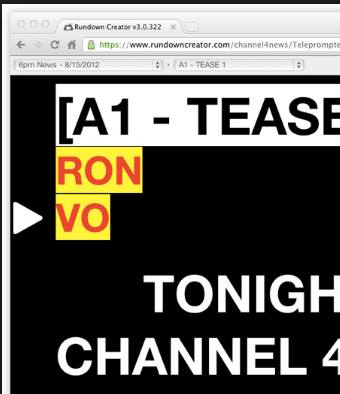On-Camera 101: How to Use a Teleprompter Like a Pro
Video marketing can take your business to the next level and get you more customers, especially if you come across as authentic. Hear from one of our founders, Charlyn Villegas, on her top tips on why and how to use a teleprompter to ensure you’re getting your message across in the best light possible. Don’t want to read? Then watch the video here:
Why use a Teleprompter?
Using a teleprompter can improve your experience on-camera, but it can also add a layer of complication. In this article, I want to help you decide 1) if you need a teleprompter, and 2) if you do, then how can you use it to deliver your message with confidence while staying connected to the crowd, and 3) how to look good while using it.
If you’re pressed for time, then using a teleprompter is a great way to ensure you are getting your points across in a shorter amount of time. Our Bay Area based video production company produces many corporate videos, so we’ve seen our fair share of executives who walk onto set with their notes on paper or on their laptop. But the biggest problem with having your script in your lap is that you’re bound to be looking at down at your notes and not at the camera. The biggest benefit to using a teleprompter is that it helps you look directly into the camera. Why is that important? Have you ever had a conversation with someone in-person or on Zoom, and they are looking everywhere else but at you? Eye contact cultivates connection, and you want to connect with your audience. This is made simple by adding a teleprompter to your set-up. So remember:
“Eye contact cultivates connection, and you can easily connect with your audience by looking directly into that lens when speaking on-camera.”
In this day and age of working from home, our video marketing company actually has a few clients who use teleprompters at home with their webcams, like this one, just so that they are confident that they are looking into the camera, but for the cost conscious, I included some tips below on how to use your current set-up to manage your eyeline. Memorizing your script is always an option too. If you’re not into memorizing notes, I highly recommend you request a prompter if your production budget allows. Adding a prompter can add $600 – $1000 to the cost of the production, and it is worth it for the ease of knowing all of your key points are accounted for.
How to Use a Teleprompter and Look Good Doing It
Whether you’re delivering a message to a camera or to a room full of people, having your notes on the prompter can help you feel prepared, but it does take some skill. First timers tend to fall into the trap of reading their script, which comes across as inauthentic. What you really want to do is find a balance between reading and presenting, so our main tip is to rehearse.
The day before you are scheduled to record, read the script out loud and time yourself. Is it as long as you thought it would be? Are there any parts that trip you up? Reduce and adjust any parts of the script that might cause you to stumble, and then read the script out loud until you are happy with your content and pacing. For more suggestions, I included our tried and true tips below, and I gathered some insider tips from our fellow industry pros on how to get the most out use of your teleprompter.
1) Create an Outline
Our favorite suggestion is to convert the script into bullet points instead of using the entire word for word script. First of all, you’ll have fewer words read through on the teleprompter, and secondly, you won’t sound like you’re reading. More on that below.
2) Don’t Read, and Don’t Speed
Avoid sounding and looking like you’re reading. This will be the hardest thing to do because you will be reading! If it sounds like you are reading your script, then you will come across as less convincing and maybe even boring. But don’t worry, there are ways to avoid looking like you’re reading. For example, if you use bullet points, you can still reference all of the important information AND you can use your own words. It’s more authentic that way.
Since people don’t want to be read to when watching a video or a presentation, it’s best if you practice, refer to bullets, and always be mindful of your eyeline. If you’re in a studio setting, the producer or director should be watching you on a monitor and can tell you if your eyes are darting back and forth like you are watching a tennis match. This usually happens if the font is too small or if the margins on your prompter are too thin, so your eyes will naturally move from left to right. Try and keep your eyeline steady, staring into the middle of your script, which is where the camera lens is. If you don’t know where to look, then sound like a pro and ask for the camera person to point it out to you.
If this is the first time you are seeing the script, then read through the entire script on the prompter before they start recording, and when you find yourself hung up on a word or sentence, ask the operator to change the language so that it’s easier for you to say/read. However, I strongly suggest you read through the script and catch this before you even enter the studio to save time.
3) Turn Up the Volume and Energy
Speak loudly and convey energy. The more enthusiastic you are, the better this will come across on-camera. I’m not talking about acting like an eager salesperson earning commission. Minor changes like speaking up and gesturing with your hands instead of hiding them will help in a major way. I like to tell first time talent that the camera tends to suck up a lot of energy, so though it might feel over the top to you, it will look better on-camera. But don’t get too excited.
“You don’t look good on video if you are bouncing around or gesturing too much,” says Marcy Golebiewski, Intel’s IT Client Services Director who has first-hand experience with using a teleprompter in the studio. She also offers the following advice, “You don’t have to memorize the copy, but you do need to practice, practice, practice… out-loud.” The more confident you feel with your script, the more energy you will convey.
4) Make Sure You Can Read the Prompter
Want to be able to see your script more easily? Then here’s a technical tip from our community: “Keep your contrast high,” says Marcus Buick, a seasoned video pro who shared this goodie on our Facebook Page, “White font (Arial) on black is the standard. Make sure font size is correct for the person reading. Always print out a copy of the text for the producer/director to follow along with. Don’t format in MS Word and expect your formatting to follow along; most prompter software looks at text only and not very much else so just be aware of that!” Dave Chung, studio director, also shares, “Put the prompter arrow (on the left side of prompter screen) where the talent is most comfortable reading so that prompter operator can have something to focus on when operating. Aligning the arrow to where the talent is comfortable looking allows the prompter op to keep the meat of their content in the right place.”
5) Be Nice to Yourself
Don’t beat yourself up. I’ve done hundreds of interviews and so many people apologize when they “mess” up or forget what they want to say. If the producer and/or director do their job correctly, then they created an environment for you that feels safe, fun, and where mistakes are absolutely allowed. The more you beat yourself up, the more this will come across in the video and the longer the session will take. You want to appear and feel confident every time they hit that record button, so when you mess up, take a breath and pick-up right where you left off. I find that after someone goes through the entire script one time, the more confident they feel during the re-takes. Also, most editors are quite skilled at removing stumbles and flaws, so rest assured, you’ll be taken care of in post.
6) Know your TRT — AKA Total Run Time
Yes, I mentioned this above, but it’s worth mentioning again. Time yourself. If you’re asked to prepare a 30-second script, then read it out loud and time yourself. You’d be surprised at how long (or not long) 30 seconds really feels. On that note, “Go at your own pace,” says Producer Jessica Ivy Distad, “Your teleprompter operator is trained to follow you. So, have confidence knowing you can slow it down and pause without the script disappearing. If you don’t have a teleprompter operator, make sure to read the script and practice!”
7) No Prompter? No Problem!
If you don’t have access to a teleprompter but feel like you really need one, then here are some options for you depending on your situation. For at home recordings, our team recommends putting the notes on the monitor in front of you and then moving your notes as close to the camera as possible. Most people use Word or even an email. Then make the font as big as you can while keeping it to just 1-page. Then stand farther back from your webcam, like 3-4′, but not too far that microphone won’t reach you. The farther back you are from the camera, the less the audience can tell that you’re not looking directly into the camera. The same method can be applied to an in-studio recording with a professional crew. Put your script on a tablet or on a computer monitor, and put that monitor on a small table directly below the camera len. Then stand as far back from the camera as you can where you can still comfortably see the script. The trick is that you are trying to get your eyeline looking toward the camera while also being able to read your notes. With either solution, you may need to read the script in chunks vs all the way through. These are not perfect solutions, but they are still better than the alternatives.
The Best Way to Get Better On-Camera
There are many more tips, but the best way to learn and get better on-camera is to practice being on-camera. A lot. It’s like building a muscle. The more reps you do, the stronger the muscle becomes. The more you put yourself on-camera, the easier it will become. Start simply by recording yourself with your phone. Pay particular attention to your eyeline and facial expressions. Read and re-read your script out loud until you’re comfortable with it. You’ll catch so much more after you see the video and hear the words that come out of your mouth.
You were selected to be on-camera for a reason, so understand that if you were chosen by your company or organization, then you bring something to the table that others don’t. With the right tools, being on-camera can be fun and easy for anyone. Follow our blog for more On-Camera 101 Tips!
About the Author:
Charlyn Villegas is a talented video producer and director and co-founder of Four Winds Creative, a Bay Area-based video production and creative agency that produces keynotes, videos, and animations for tech companies in the Silicon Valley and beyond.


